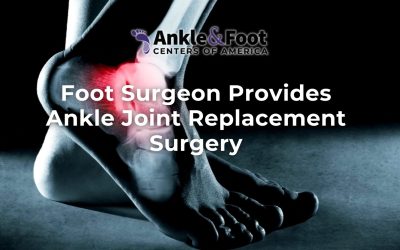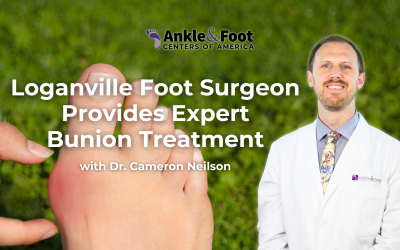Table of Contents
Introduction
Heel pain in children is a common concern that warrants careful attention due to its potential impact on a child’s daily activities and overall well-being. As children continuously grow and develop, their musculoskeletal system undergoes dynamic changes, rendering them susceptible to various foot conditions, with heel pain being a prevalent issue.
Understanding Heel Pain in Kids
Heel pain in children is a prevalent concern that requires careful consideration and specialized attention, exploring various aspects such as common causes, the influence of growth and development, and signs parents should be aware of.
Common Causes of Heel Pain in Kids
 Sever’s Disease
Sever’s Disease
Sever’s disease, despite its name, is not a pathological condition but rather a growth-related issue. It occurs when the growth plate at the back of the heel bone becomes inflamed, often during periods of rapid growth. This condition is particularly prevalent in active children who engage in sports or physical activities.
Explanation of Growth-Related Factors: During growth spurts, the bones may elongate more rapidly than the surrounding muscles and tendons, leading to tension and stress on the growth plate.
Symptoms and Associations with Physical Activities: Children experiencing Sever’s disease may exhibit symptoms such as heel tenderness, especially during or after physical activities.
Understanding these associations is crucial for identifying and addressing the condition promptly.
Plantar Fasciitis
Plantar fasciitis, commonly associated with adults, is a condition that can also affect children, impacting their comfort and mobility. In this section, we will explore the nuances of plantar fasciitis in the pediatric population, emphasizing its connection to the inflammation of the plantar fascia.
Plantar fasciitis is a condition characterized by the inflammation of the plantar fascia, a thick band of tissue that spans the bottom of the foot, connecting the heel bone to the toes. This crucial structure plays a pivotal role in supporting the arch of the foot and absorbing shock during activities like walking and running.
While less common in children compared to adults, plantar fasciitis can still manifest, especially in those engaged in sports or physical activities that place repetitive stress on the feet. Understanding its occurrence in children requires a closer look at the factors contributing to its development.
The primary hallmark of plantar fasciitis is inflammation. In children, this inflammation typically occurs at the point where the plantar fascia attaches to the heel bone. The repetitive stress or strain on the foot, often exacerbated by improper footwear, can lead to micro-tears in the plantar fascia, triggering an inflammatory response.
Factors Contributing to Pediatric Plantar Fasciitis
- Improper Footwear: Inappropriate shoes lacking proper arch support or cushioning can increase the risk of plantar fasciitis in children.
- Excessive Physical Activity: Children involved in high-impact sports or activities that involve prolonged standing may be more susceptible to the development of this condition.
- Growth-Related Stress: As children go through growth spurts, the bones, muscles, and tendons may experience uneven development, placing additional stress on the plantar fascia.
- Symptoms to watch for in Children: Recognizing the symptoms of plantar fasciitis in children is crucial for early intervention. Common indicators include heel pain, especially during the first steps in the morning or after periods of inactivity, and discomfort during physical activities.
Achilles Tendonitis
Achilles tendonitis is the inflammation of the Achilles tendon, a robust band of tissue responsible for facilitating movement in the ankle and foot. In active children, this condition can arise due to repetitive stress or strain, particularly in instances of heightened physical activity or improper biomechanics.
Factors Contributing to Pediatric Achilles Tendonitis
Active children engaged in sports or activities involving running and jumping are susceptible to overuse injuries, and the Achilles tendon is no exception. The relentless demands placed on the tendon without adequate periods of rest can lead to inflammation.
Improper Footwear: The importance of proper footwear cannot be overstated. Ill-fitting shoes lacking proper support can contribute to biomechanical imbalances, increasing the strain on the Achilles tendon. As children’s feet continue to develop, the choice of footwear becomes a crucial factor in preventing tendon-related issues.
Symptoms of Achilles Tendonitis in Children
- Pain: Children with Achilles tendonitis may experience pain at the back of the heel. This discomfort is often exacerbated during physical activities or after periods of inactivity.
- Swelling: Inflammation of the Achilles tendon can lead to noticeable swelling, particularly around the back of the heel. Parents should be attentive to any visible changes in the appearance of the heel, such as redness or swelling.
- Exploration of the Impact on a Child’s Daily Activities: Achilles tendonitis, if left unaddressed, can significantly impact a child’s daily life. The pain and discomfort associated with this condition may result in alterations in gait or mobility, affecting their participation in sports and recreational activities.
The Impact of Growth and Development on Heel Pain
Children experience remarkable growth, marked by dynamic changes in bones, muscles, and tendons. This dynamic nature is a key element of their overall development, setting the stage for the potential emergence of heel pain.
Understanding Growth Spurts
Growth spurts, periods of accelerated growth, often lead to uneven development within the musculoskeletal system. Bones may elongate at different rates than muscles and tendons, creating imbalances that can contribute to stress on the heels.
The asynchronous growth rates among bones, muscles, and tendons present unique challenges. While bones rapidly lengthen during growth spurts, muscles and tendons may take time to adapt to these changes. This discrepancy in growth rates can result in tension, particularly on the vulnerable structures of the heel.
Ensuring a balanced growth trajectory is crucial for preventing undue stress on the heel. Imbalances in growth can contribute to conditions like Sever’s disease, where the growth
plate at the back of the heel becomes inflamed.
Signs and Symptoms to Look Out For
Active children, driven by their innate energy and enthusiasm, frequently engage in sports, play, and other physical activities. When heel pain is present, these activities can become moments of discomfort and distress for the child.
 Pain During Activities
Pain During Activities
Children may express their discomfort verbally, describing sensations of pain, tenderness, or soreness during or after activities. It’s essential for parents to be attentive to these verbal cues, as they offer direct insights into the child’s experience.
In some instances, children may not explicitly communicate their pain but might exhibit subtle behavioral changes. These can include a reluctance to participate in certain activities, a decrease in overall enthusiasm, or a shift in their usual level of engagement.
Observe Physical Reactions: Actively observe your child’s physical reactions during and after activities. Signs such as wincing, grimacing, or favoring one foot over the other can indicate localized discomfort in the heel region.
Limping or Altered Gait
Observing changes in a child’s walking pattern, such as limping or an altered gait, can be a crucial indicator of underlying heel pain. In this section, we will delve into the significance of limping or altered gait as telltale signs, offering insights for parents to recognize these manifestations and take proactive steps toward addressing potential heel issues.
Limping or an altered gait refers to changes in the way a child walks, moves, or distributes weight on their feet. When heel pain is present, children may instinctively modify their gait to minimize discomfort, making these alterations noticeable to observant parents.
Morning Heel Pain
Morning heel pain in children can be a distinctive symptom associated with certain foot conditions. This section explores the phenomenon of morning heel pain, shedding light on its characteristics, potential causes, and offering insights for parents to recognize and address this specific manifestation.
Morning heel pain refers to discomfort or pain experienced in the heels during the initial steps a child takes after waking up. This phenomenon is often linked to conditions affecting the foot structures and is a notable indicator that parents should be attentive to.
Diagnosis and Evaluation
Understanding and accurately diagnosing the root cause of heel pain in children is a crucial aspect of effective treatment. Dr. Jennifer Monaco employs a comprehensive and specialized approach to diagnosis, utilizing a range of techniques to ensure precision and tailored care.
Importance of Accurate Diagnosis
Dr. Monaco emphasizes the significance of pinpointing the specific cause of heel pain in children to tailor treatment plans effectively. An accurate diagnosis enables her to address the underlying issues, promoting optimal recovery and preventing the recurrence of symptoms.
Specialized Techniques Used by the Specialist
Physical Examination:
- Dr. Monaco conducts a meticulous physical examination, assessing factors such as gait, range of motion, and foot structure.
- Hands-on evaluation helps identify areas of tenderness, inflammation, or abnormalities contributing to heel pain.
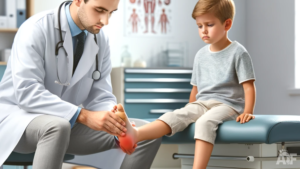
Imaging Studies:
- When necessary, Dr. Monaco may utilize imaging studies, such as X-rays or ultrasound, to visualize the internal structures of the foot.
- These diagnostic tools provide a detailed view of the bones, joints, and soft tissues, aiding in the identification of any abnormalities.
Gait Analysis:
- Gait analysis is a specialized technique employed by Dr. Monaco to evaluate the child’s walking pattern.
- Observing how the child distributes weight and moves during walking helps in identifying any irregularities that may contribute to heel pain.
Treatment Options
When addressing heel pain in children, Dr. Jennifer Monaco employs a range of treatment options tailored to the specific needs of each young patient. Her approach encompasses non-invasive strategies, medical interventions, and, when necessary, surgical solutions, all aimed at providing effective relief and promoting long-term foot health.
Non-Invasive Approaches
Rest and Activity Modification:
- Dr. Monaco often recommends a period of rest and modified activity to allow the affected foot to heal.
- Limiting high-impact activities and providing adequate rest are essential components of this approach.
Physical Therapy:
- Physical therapy plays a key role in strengthening the muscles and supporting structures around the heel.
- Dr. Monaco collaborates with experienced pediatric physical therapists to design customized exercise regimens that address the specific needs of each child.
Orthotic Devices:
- Custom orthotic devices may be prescribed to provide additional support and alignment.
- These devices are crafted to fit the unique contours of the child’s feet, helping to alleviate pressure on the affected area.
Medical Interventions
Medications for Pain and Inflammation:
- In cases of inflammation, Dr. Monaco may recommend over-the-counter or prescription medications to manage pain and reduce swelling.
- This approach is often part of a comprehensive treatment plan designed to address the underlying causes of heel pain.
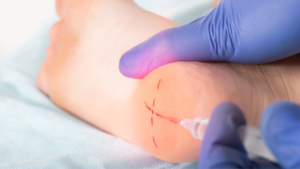
Corticosteroid Injections (if applicable):
- In certain instances, corticosteroid injections may be considered to alleviate severe inflammation.
- Dr. Monaco carefully evaluates the risks and benefits of this intervention, ensuring it aligns with the child’s overall health.
Surgical Options (if Necessary)
Dr. Monaco discusses surgical options only when conservative measures have proven ineffective. Post-surgery, Dr. Monaco provides comprehensive guidance on recovery protocols and follow-up care. Monitoring the child’s progress ensures a smooth transition to normal activities with minimal risk of recurrence.
Preventative Measures
Preventing heel pain in children involves a proactive approach that focuses on maintaining optimal foot health and minimizing risk factors. Dr. Jennifer Monaco empowers parents and caregivers with practical advice to promote healthy foot development and reduce the likelihood of heel pain.
Appropriate Footwear
Dr. Monaco emphasizes the importance of well-fitted and supportive footwear for children. Guidance on choosing shoes with proper arch support and cushioning to alleviate stress on the heels.
Monitoring Physical Activity
Parents are encouraged to be mindful of their child’s physical activity levels. Dr. Monaco provides recommendations for age-appropriate exercises and activities that promote foot health without placing excessive strain on growing feet.
Regular Foot Checks
Routine foot checks at home are essential to identify any early signs of discomfort or abnormalities. Dr. Monaco educates parents on what to look for during these checks, including changes in gait, swelling, or redness.
Importance of Early Intervention
Dr. Monaco underscores the significance of addressing any signs of heel pain promptly. Early intervention not only prevents the progression of existing conditions but also reduces the likelihood of long-term complications.

Dr. Monaco in Columbus, GA: A Trusted Specialist for Heel Pain in Children
Dr. Jennifer Monaco, a renowned pediatric orthopedic specialist based in Columbus, Georgia, stands as a beacon of expertise in the field of children’s musculoskeletal health. With a wealth of experience and a dedication to providing compassionate care, Dr. Monaco has become a go-to professional for parents seeking specialized assistance in managing heel pain in their children.
Dr. Monaco brings a wealth of expertise to the table when it comes to diagnosing heel pain in children. With a meticulous and comprehensive approach, she employs advanced examination techniques to identify the root causes of heel pain. Her commitment to accuracy ensures that parents receive a clear understanding of their child’s condition, allowing for informed decision-making regarding treatment options.
Tailored Treatment Plans
Understanding that each child is unique, Dr. Monaco crafts personalized treatment plans tailored to the specific needs of her young patients. Whether the heel pain stems from conditions like plantar fasciitis or Sever’s disease, Dr. Monaco combines evidence-based practices with a compassionate touch, ensuring that the child’s comfort and well-being remain at the forefront of the treatment strategy.
Emphasis on Preventive Measures
Dr. Monaco goes beyond treating immediate concerns, actively advocating for preventive measures to safeguard a child’s musculoskeletal health. Her guidance on proper footwear, incorporation of preventive exercises into a child’s routine, and strategic monitoring of growth spurts contribute to the long-term well-being of her patients.
In conclusion, Dr. Monaco in Columbus, GA, emerges as a trusted ally for parents navigating the challenges of heel pain in their children. Her expertise, personalized approach, and commitment to community well-being make her a valuable resource for families seeking the best possible care for their little ones. If you’re in the Columbus area and your child is experiencing heel pain, Dr. Monaco is the specialist you can rely on for compassionate and expert assistance.


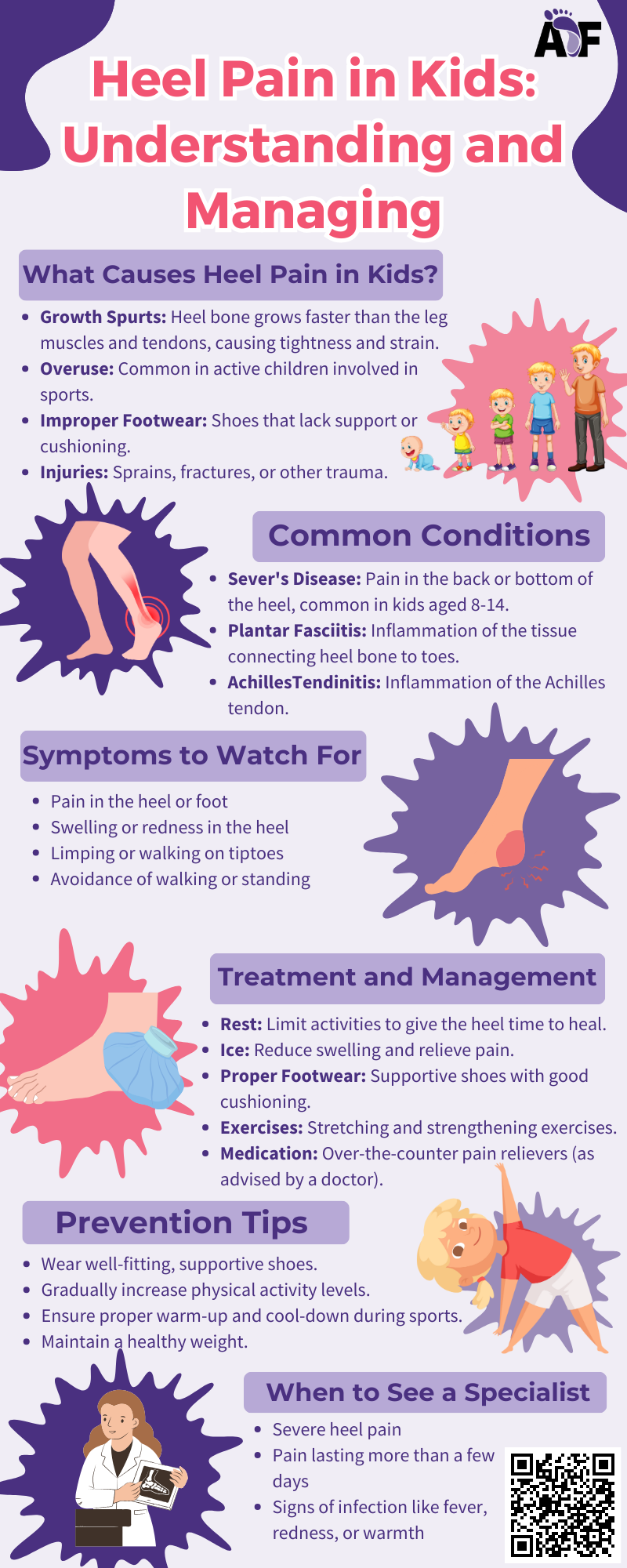
 Pain During Activities
Pain During Activities


